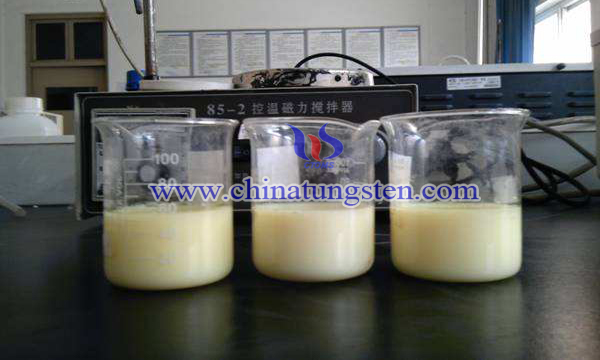Nano Tungsten Trioxide Preparation by Sol-gel Method
- Details
- Category: Tungsten Information
- Published on Wednesday, 30 October 2019 22:28
In recent years, more and more researchers have paid attention to the preparation of core-shell inorganic / polymer nanocomposite particles by coating polymer on the surface of inorganic nano particles, which has broad application prospects in microelectronics, optoelectronics, biological and medical materials and other fields.

The preparation of core-shell nanocomposites is mainly divided into several methods, such as interface polymerization, condensed phase separation, drying bath and sol-gel method. Among them, the sol-gel method is a low-cost method, which can chemically bond a layer of polymer on the surface of the tungsten trioxide nanospheres, and then form the tungsten trioxide polymer nanospheres with the core of the nanospheres and the shell of the polymer. The process of this method is as follows:
(1)0.5-5g tungstic acid and 1.26-12.6g citric acid were prepared into water solution at the molar ratio of 3:1. Under the condition of continuous agitation and 55-70 ℃, the pH of the solution was adjusted to 8-12 with ammonia water to form tungsten trioxide / citric acid chelate solution. The solution was heated at 45-100 ℃ for 8-36 hours to form gel like precursor, and burned at 500-900 ℃ for 1-12 hours to form tungsten trioxide nanometer precursor powder;
(2)Weigh 0.1-1.5g of tungsten trioxide nano powder and disperse it in 10-50ml of anhydrous ethanol, add 5-50ml of 0.025g/ml of coupling agent solution drop by drop, react for 30-40h in water bath at 30-40 ℃ and dry in vacuum at 25-45 ℃ for more than 12h to obtain the coupling agent treated tungsten trioxide nano powder;
(3)In a three port flask equipped with a reflux condensing device, 0.5-5g of the above-mentioned coupling agent treated tungsten trioxide nano powder is ultrasonically dispersed in 10-50ml of anhydrous ethanol, and 0.1-1.0g of buffer, 0.05-0.5g of emulsifier and 50-250ml of deionized water are added at the same time. After the ultrasonic dispersion is uniform, 5-25ml of monomer is added. After 0.5-4h of pre emulsification at 45-60 ℃, the temperature rises to 75-85 ℃, and drops are made. The aqueous solution of persulfate with a concentration of 5 to 50ml was added for 6~24 hours after dropping. After that, the white emulsion was stopped. The emulsion was centrifugally filtered and purified, then washed with toluene to remove homopolymer. After 60~100 hours of vacuum drying for more than 12 hours, the tungsten trioxide polymer nano core shell particles were obtained. At the same time, 0.012g/ml was obtained.
Nano tungsten trioxide particles were prepared by sol-gel method, and then the functional groups which could react with ethylene monomer were introduced on the surface of tungsten trioxide particles by coupling agents. Then, the surface of tungsten trioxide particles was polymerized by microemulsion polymerization to form three oxygen tungsten core shell microspheres. The interface between the core layer of tungsten trioxide and the shell layer of polymer will be greatly enhanced by chemical bond. Moreover, coating polymer materials on the surface of tungsten oxide nano particles can prevent the interaction between the external environment and tungsten oxide nano particles, change the optical, thermal, electrical or surface activity of tungsten oxide nano particles, improve the dispersion of tungsten oxide nano particles, improve their affinity with organic solvents, polymers, etc., and nano tungsten oxide. Rice particles and other organic semiconductors are effectively modified to improve their photoelectric performance or processing performance, so that they can meet a variety of special needs, so they have high application value.
- Tungsten Oxide Manufacturer & Supplier, Chinatungsten Online: www.tungsten-oxide.com
- Tungsten News & Prices of China Tungsten Industry Association: www.ctia.com.cn
- Molybdenum News & Price: news.molybdenum.com.cn
- Tel.: 86 592 5129696; Fax: 86 592 5129797; Email: sales@chinatungsten.com



 sales@chinatungsten.com
sales@chinatungsten.com